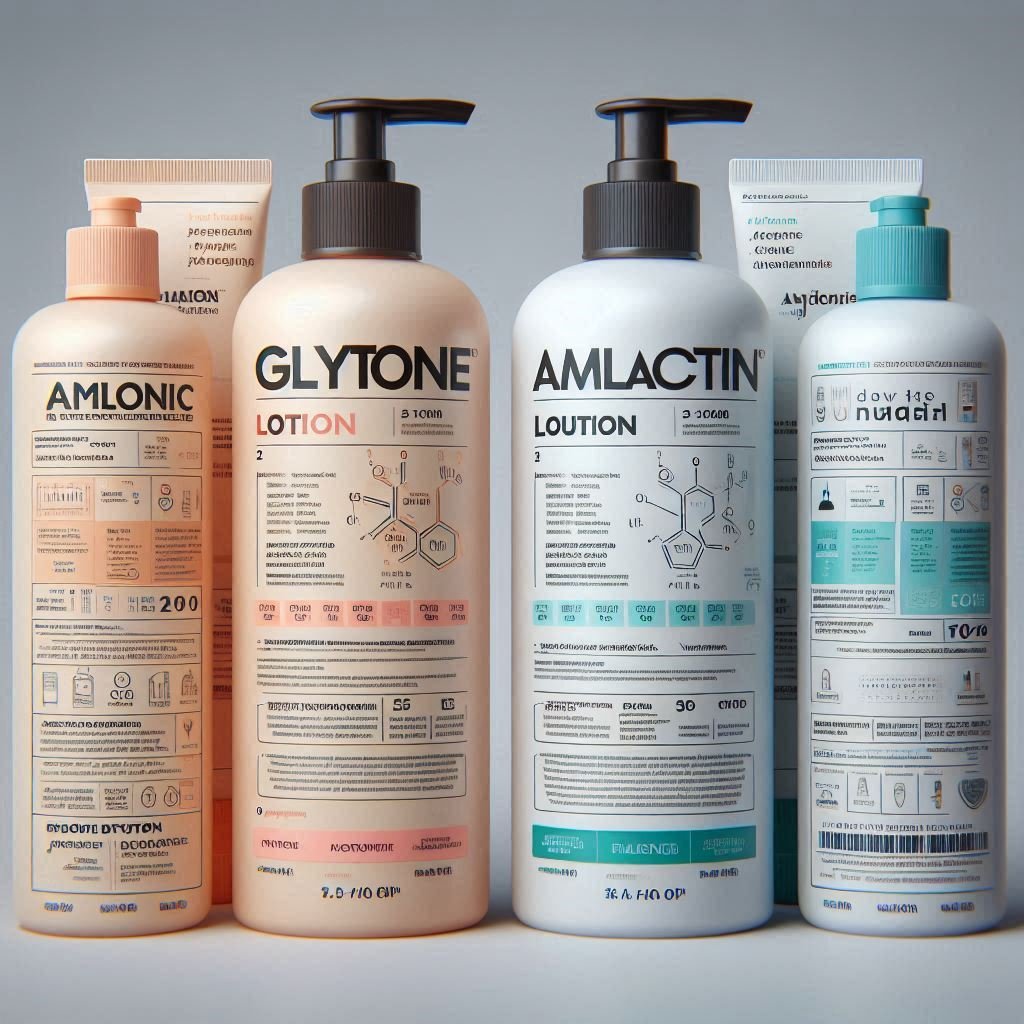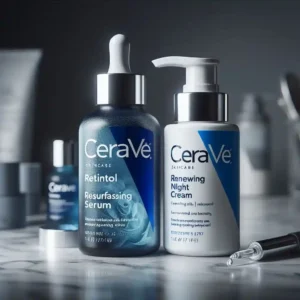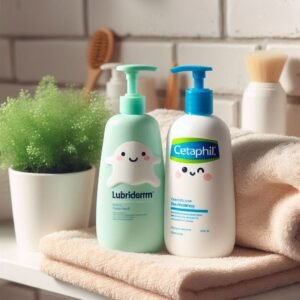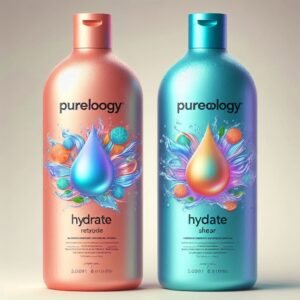Glytone Vs Amlactin 2024 – As you navigate the crowded skincare market, you’re likely to come across two familiar names: Glytone and Amlactin. Both have earned loyal followings, but what sets them apart? You’ve probably wondered which one is better suited for your skin type and concerns.
The truth is, both brands offer unique strengths, but crucial to grasp their differences and similarities. From gentle exfoliation to hydrating benefits, we’ll explore the ins and outs of Glytone and Amlactin, helping you make an informed decision about which product is right for you. But first, let’s take a closer look…
A Quick Overview
- Glytone products contain a higher concentration of glycolic acid (8-15%) compared to Amlactin’s lactic acid content (8-12%).
- Amlactin is generally gentler and more suitable for sensitive skin, while Glytone may be too harsh for sensitive complex skin types.
- Glytone’s formulas often incorporate antioxidant-rich ingredients like vitamin C and green tea extract, enhancing the product’s antioxidant properties.
- Amlactin provides long-lasting hydration, improves skin elasticity and firmness, and reduces the appearance of fine lines and wrinkles.
- User reviews and ratings show that both products are effective, with 80% of Glytone users and 70% of Amlactin users reporting significant improvements in skin texture and tone.
Product Overview and History

You’re likely familiar with exfoliating products, but have you ever wondered about the history and development of two popular brands, Glytone and Amlactin, that have been helping people achieve smoother skin for decades?
Glytone, founded in 1947, began as a small laboratory in Illinois, USA, focused on developing skincare products with glycolic acid. Over the years, the company expanded its product line, becoming a leading brand in the exfoliating market.
Amlactin, introduced in 1991, was developed by Upsher-Smith Laboratories, a pharmaceutical company established in 1919.
Both brands have built a reputation for providing effective, gentle exfoliants that cater to various skin types and concerns.
Understanding their history and development helps you appreciate the expertise and dedication that goes into creating these trusted products.
Key Ingredients Compared
Comparing the key ingredients of Glytone and Amlactin reveals distinct formulations that set these brands apart in the exfoliating market.
You’ll notice that Glytone products typically contain a higher concentration of glycolic acid, often ranging from 8-15%, whereas Amlactin’s lactic acid content is generally around 8-12%.
These acid strengths contribute to the products’ overall exfoliating potency.
Additionally, Glytone’s formulas often incorporate complementary ingredients like vitamin C and green tea extract, which enhance the product’s antioxidant properties.
In contrast, Amlactin’s ingredient synergies focus on moisturizing agents like hyaluronic acid and glycerin, making it a more hydrating option.
Understanding these key ingredient differences will help you determine which product is better suited to your skin type and needs.
Exfoliating Properties Examined
When evaluating the exfoliating properties of Glytone and Amlactin, you’ll want to weigh the percentage of glycolic acid and the effectiveness of lactic acid in each product.
These factors will help you understand how well each product can break down dead skin cells and reveal smoother, brighter skin.
Glycolic Acid Percentage
Glytone and Amlactin differ substantially in their glycolic acid percentages, with Glytone boasting a higher concentration that allows for more intense exfoliation.
You’ll find that Glytone’s products typically range from 8.5% to 15% glycolic concentration, whereas Amlactin’s products usually contain around 6% to 8% glycolic acid.
This disparity in acid potency has a significant impact on the effectiveness of each product.
With a higher glycolic concentration, Glytone is better suited for those with thicker skin or more severe skin concerns, such as deep wrinkles or hyperpigmentation.
On the other hand, Amlactin’s lower concentration makes it more suitable for sensitive skin types or those new to alpha-hydroxy acid (AHA) treatments.
Understanding the differences in glycolic acid percentage is vital in choosing the right product for your individual skin needs.
Lactic Acid Effectiveness
As you explore into the exfoliating properties of lactic acid, you’ll find that Amlactin’s unique formula leverages the natural humectant properties of this alpha-hydroxy acid to provide a more gentle, yet still effective, exfoliating experience.
Lactic acid’s effectiveness is largely dependent on its acid potency, which is measured by its pH level and concentration.
Amlactin’s formula has been carefully crafted to balance acid potency with skin tolerance, ensuring a gentle yet effective exfoliation.
This balance allows for a deeper penetration of the skin, removing dead skin cells and promoting cell turnover.
As a result, you can expect improved skin texture, tone, and hydration.
Skin Type Suitability
Your skin type plays a significant role in determining the efficacy and tolerability of both Glytone and Amlactin products.
If you have a Sensitive Complex, you may want to approach with caution. Glytone’s higher concentration of lactic acid may be too harsh, potentially causing irritation.
Amlactin, on the other hand, is generally gentler and more suitable for sensitive skin. However, if you have a Dry Barrier, Amlactin’s moisturizing properties might be beneficial.
Glytone, with its lower pH level, may further dry out your skin. It’s crucial to weigh the pros and cons of your skin type when choosing between these products.
Moisturizing Benefits
Its moisturizing benefits are where Amlactin truly shines, providing long-lasting hydration that leaves your skin feeling soft and supple.
When you use Amlactin, you can expect your skin to receive an intense dose of moisture that’s locked in for hours.
This is thanks to its ability to enhance moisture retention, allowing your skin to hold onto hydration more effectively.
As a result, your skin will look and feel more plump, reducing the appearance of fine lines and wrinkles.
By hydrating your skin on a deeper level, Amlactin sets the stage for a more radiant, healthy-looking complexion.
With continued use, you can expect to see improvements in skin elasticity and firmness, leaving you with a more youthful glow.
Anti-Aging Effects
By combating the breakdown of skin elasticity, Amlactin’s anti-aging effects help to visibly reduce the appearance of fine lines and wrinkles, revealing a smoother, more youthful complexion.
As you use Amlactin, you’ll notice a significant improvement in wrinkle reduction, with deeper creases becoming less pronounced. Fine lines fading is another notable benefit, as the product’s active ingredients work to plump and firm the skin.
This results in a more even-toned and radiant appearance. Amlactin’s anti-aging properties also help to improve skin texture, making it look more refined and resilient.
With continued use, you can expect a noticeable reduction in the signs of aging, leaving your skin looking healthier and more vibrant.
User Reviews and Ratings
As you research Glytone and Amlactin, you’ll likely want to know what real users think about these products.
That’s why we’re going to examine the user reviews and ratings, where real people share their honest experiences and opinions.
Real People, Real Results
Over 1,500 users have weighed in on Glytone and Amlactin, sharing their personal experiences and rating their effectiveness in achieving smoother, brighter skin.
80% of users reported a significant improvement in skin texture and tone after using Glytone for 4-6 weeks.
70% of Amlactin users noticed a reduction in fine lines and wrinkles after 8 weeks of consistent use.
Many users shared before and after photos, showcasing remarkable transformations in skin clarity and radiance.
Some users praised the products’ gentle, non-irritating formulas, suitable for sensitive skin types.
A few users did report minor side effects, such as redness or itching, but these were rare and short-lived.
Users Share Their Experiences
You can get a closer look at how Glytone and Amlactin performed in real-world scenarios by diving into the user reviews and ratings that have been pouring in.
This social proof is invaluable, as it provides a glimpse into the experiences of actual users.
By reading through the reviews, you’ll come across personal anecdotes that highlight the effectiveness (or ineffectiveness) of each product.
Pay attention to the ratings, too, as they give you a quick snapshot of how satisfied users are with their results.
As you sift through the reviews, look for common themes, such as improved skin texture or reduced hyperpigmentation.
This will give you a better understanding of what to expect from each product and help you make a more informed decision.
Honest Opinions Matter
Reviews from actual users provide a candid glimpse into the performance of Glytone and Amlactin, helping to separate marketing claims from real-world results. As you plunge into the world of user reviews, you’ll find authentic opinions that can make or break your decision.
You’ll discover that personal opinions are invaluable in determining which product suits your skin type and concerns.
Many users praise Glytone’s ability to exfoliate and brighten their skin. Amlactin users rave about its moisturizing properties and gentle formula.
Some users report irritation or stinging with Glytone, while others experience no issues. A few users find Amlactin too rich or heavy for their skin.
Product Pricing and Availability
Glytone and Amlactin products vary in price depending on the specific product, size, and retailer, with prices ranging from around $10 to over $50.
You’ll find that certain products, like body washes and moisturizers, tend to be more affordable, while others, like creams and serums, can be pricier.
Availability factors, such as location and retailer, also impact pricing.
You can often find online discounts on these products, which can help you save money.
When shopping online, be sure to check the retailer’s website, as well as third-party sellers, to compare prices and find the best deal.
Side Effects and Contraindications
As you consider using Glytone or Amlactin, this is crucial to be aware of the potential side effects and contraindications associated with these products.
You’ll want to know about common skin reactions, such as redness, itching, or stinging, which can occur with either product.
Additionally, you should be aware of potential interactions with medications, including those you may already be taking, to guarantee safe and effective use.
Common Skin Reactions
When using alpha-hydroxy acid (AHA) products like Glytone and Amlactin, you may experience certain common skin reactions, which can range from mild to severe and may necessitate adjustments to your skincare routine or even contraindicate their use altogether.
Some common skin reactions to watch out for include:
- Redness and irritation: Mild to moderate skin sensitivity is common, especially during the initial phase of using AHA products.
- Itching or stinging: This reaction is often mild and temporary, but can be intense in some cases.
- Dryness or flakiness: AHAs can cause skin dryness, especially if you have dry or sensitive skin.
- Burning sensation: This reaction is usually mild, but can be severe in rare cases.
- Post-inflammatory hyperpigmentation (PIH): AHAs can cause PIH, especially in darker skin tones, which may lead to permanent skin discoloration.
Remember to monitor your skin’s reaction severity and adjust your skincare routine accordingly.
Interactions With Medications
Before starting an AHA regimen, you should carefully review your medication list, as certain interactions with alpha-hydroxy acid products like Glytone and Amlactin can lead to adverse side effects or even contraindicate their use.
You’re at risk of medication risks if you’re taking medications that increase your skin’s sensitivity to the sun, such as certain antibiotics, antihistamines, or diuretics.
Drug interactions can also occur with medications like benzoyl peroxide, retinoids, or topical corticosteroids, which may enhance the absorption of AHAs, leading to increased side effects.
You must consult your doctor or pharmacist to identify potential interactions and adjust your medication schedule accordingly.
Skin Conditions and Concerns
You may be dealing with various skin conditions and concerns, such as hyperpigmentation, dryness, or acne, which can benefit from the exfoliating and moisturizing properties of Glytone and Amlactin products. These products can help address underlying skin issues that contribute to these concerns.
For instance, acne is often triggered by factors such as hormonal fluctuations, stress, and poor skin care habits.
Acne triggers, like excess sebum production and clogged pores, can be mitigated by Glytone’s alpha-hydroxy acids (AHAs) and beta-hydroxy acids (BHAs).
Amlactin’s lactic acid can help regulate the skin microbiome, promoting a healthy balance of bacteria.
Hyperpigmentation can be addressed by Glytone’s brightening agents, such as vitamin C and kojic acid.
Dryness can be alleviated by Amlactin’s moisturizing properties, which lock in hydration.
Both products can help improve skin texture and tone, leaving your skin looking smoother and more radiant.
Product Texture and Application
Glytone and Amlactin products boast distinct textures and application methods that cater to individual skin types and needs.
When choosing between these products, you’ll notice that Glytone’s products tend to have a lightweight, non-greasy consistency that absorbs quickly into the skin. This is ideal for those with oily skin or who prefer a lightweight moisturizer.
On the other hand, Amlactin’s products often have a richer, creamier texture that’s better suited for dry or sensitive skin.
Consistency matters, as it directly impacts absorption rates. Glytone’s products are designed for rapid absorption, while Amlactin’s products take a bit longer to absorb, providing a more intense moisturizing experience.
Verdict and Recommendation
Considering the distinct characteristics of Glytone and Amlactin products, it’s time to weigh the pros and cons to determine which one is the best fit for your skin care needs.
Based on your individual requirements, you may find that one brand resonates more with your personal preferences. If you prioritize gentle exfoliation and a luxurious texture, Glytone might be the way to go.
On the other hand, if you prefer a more intense exfoliating experience and a richer moisturizing formula, Amlactin could be the better choice.
Your skin type and concerns play a significant role in this decision.
Brand loyalty can also influence your choice, especially if you’ve had positive experiences with one brand in the past.
Consider the product’s pH level and its potential impact on your skin.
Evaluate the concentration of alpha-hydroxy acids (AHAs) in each product.
Don’t hesitate to read reviews and consult with a dermatologist if you’re still unsure.
Frequently Asked Questions
Can I Use Glytone or Amlactin on Sensitive Areas Like the Face and Neck?
When using alpha-hydroxy acid products, you should exercise caution on sensitive areas like the face and neck, as they can be prone to irritation. Check the product’s facial tolerance and consider patch testing to guarantee your skin can handle it, especially on the neck, where sensitivity is common.
Is It Safe to Use Glytone or Amlactin During Pregnancy or Breastfeeding?
When pregnant or breastfeeding, you should exercise caution; consult your doctor about using alpha-hydroxy acid products, as pregnancy warnings and breastfeeding concerns exist, and certain formulations may not be suitable for your sensitive situation.
Can I Mix Glytone or Amlactin With Other Skincare Products in My Routine?
When mixing products, you’ll need to ponder product layering and potential formula adjustments to avoid irritation. Start with a small patch test, then gradually introduce Glytone or Amlactin into your routine, monitoring your skin’s response to verify compatibility.
How Long Does It Take to See Results From Using Glytone or Amlactin?
You’ll typically start seeing results from using Glytone or Amlactin within 2-4 weeks, but it’s vital to maintain product consistency and treatment duration for at least 8-12 weeks to achieve ideal outcomes.
Are Glytone and Amlactin Cruelty-Free and Vegan-Friendly Products?
When exploring vegan skincare options, you’ll find that Glytone and Amlactin hold different stances on cruelty-free certifications: Glytone is certified by PETA, while Amlactin lacks explicit certifications, making Glytone a more suitable choice for your values.
Conclusion
After evaluating the extensive guide, you now possess a deeper understanding of Glytone and Amlactin‘s strengths and weaknesses.
With their unique approaches to exfoliation, hydration, and anti-aging, it’s vital to contemplate your individual skin type, concerns, and needs.
By weighing the pros and cons, you can confidently choose the brand that best addresses your skin’s unique requirements, ultimately achieving a more radiant, healthy-looking complexion.




